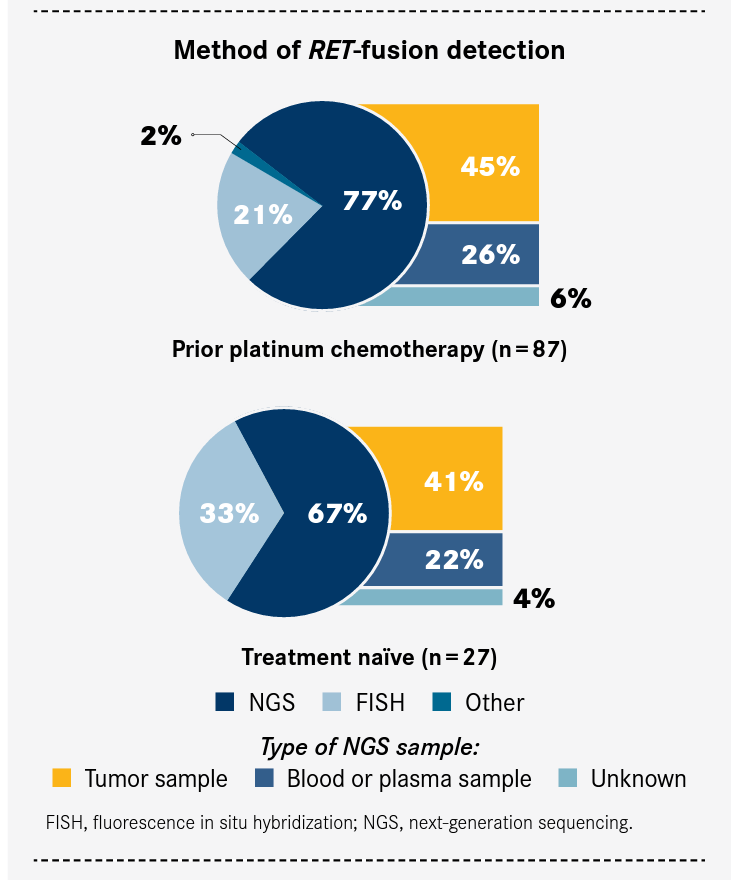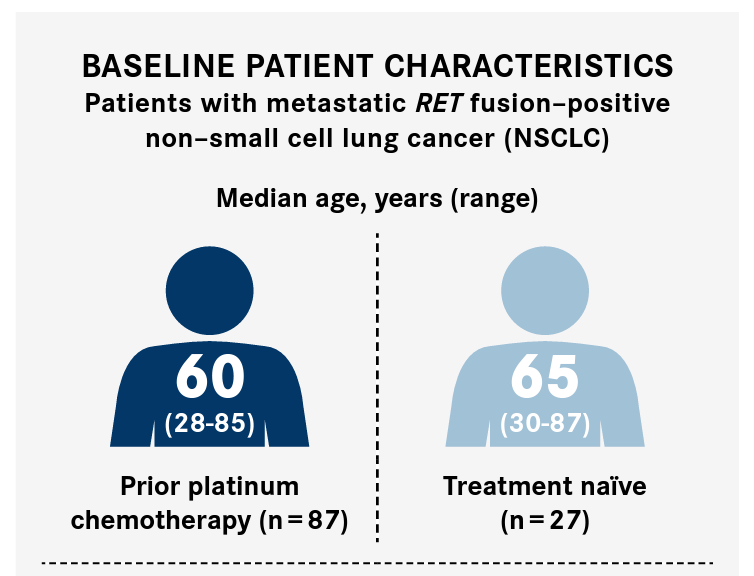Publication
Article
Oncology Live®
NSCLC Treatment Portfolio Gains RET-Targeted Therapy
Author(s):
In an interview with OncologyLive®, Justin F. Gainor, MD, discusses the impact pralsetinib may have on the RET-altered NSCLC paradigm.
Justin F. Gainor, MD

The Portfolio of precision medicine strategies for RET-mutant cancers has further expanded with pralsetinib (Gavreto), a selective kinase inhibitor that targets oncogenic RET fusions in non–small cell lung cancer (NSCLC).1
On September 4, 2020, the FDA granted accelerated approval to pralsetinib for adults with metastatic RET fusion–positive NSCLC as detected by an FDA-approved test. The regulatory decision was based on efficacy data from the phase 1/2 ARROW trial (NCT03037385) that enrolled patients with RET-altered tumors, including metastatic RET fusion–positive NSCLC previously treated with platinum chemotherapy and treatment-naïve RET fusion–positive NSCLC.1
Method of RET-fusion detection

Results showed that pralsetinib elicited durable responses, with 57% and 70% of patients with previously treated and treatment-naïve disease experiencing a response lasting 6 months or longer, respectively. A benefit was also observed in patients with measurable central nervous system (CNS) metastases at baseline who received prior platinum chemotherapy. Responses in intracranial lesions were observed in 4 of the 8 patients with CNS metastases and included 2 CNS complete responses. Seventy-five percent of responders had a duration of response greater than or equal to 6 months.2
Baseline patient characteristics on the ARROW study.

In an interview with OncologyLive®, Justin F. Gainor, MD, an author of the ARROW study and director of the Center for Thoracic Cancers and of Targeted Immunotherapy in the Henri and Belinda Termeer Center for Targeted Therapies at Massachusetts General Hospital in Boston, discussed the the impact the agent may have on the RET-altered NSCLC paradigm.
What was noteworthy about the efficacy data that led to the approval?
The approval was based on data from the registrational ARROW study. This was a phase 1/2 study that explored pralsetinib in RET fusion–positive lung cancer and in several other cohorts, including medullary thyroid cancer and RET fusion–positive solid tumors. In this study, the registrational data set included 87 patients with RET fusion–positive non–small cell lung cancer that had been previously treated with platinum doublet chemotherapy. Within that cohort, we observed an objective response rate of 57%. This was significantly better than what we’ve historically seen with multikinase inhibitors. Importantly, 6% of patients had a complete response. It is quite impressive for us to see complete responses in a solid tumor like lung cancer.
Within the broader cohort of patients with non–small cell lung cancer, there were 27 patients with treatment-naïve disease, and we observed an objective response rate of 70% among those patients, including 11% of patients who experienced a complete response. Collectively, these data show that use of a highly selective RET inhibitor can induce robust responses in the vast majority of patients with RET fusion–positive non–small cell lung cancer.
Most common RET-fusion partners.

The central nervous system is an important sanctuary state of disease for patients with lung cancer. We’ve certainly seen in the targeted therapy field in lung cancer that it is really critical to have CNS-penetrant targeted therapies for patients with RET fusion–positive lung cancer. We know that the lifetime prevalence of brain metastases is close to 50%, so having a CNS penetrant agent is important. In the ARROW study, we saw that among patients with measurable intracranial disease at study entry, more than half of these patients had intracranial responses, suggesting that pralsetinib does enter the CNS and is capable of producing significant CNS activity.
Please describe the mechanism of action.
RET rearrangements lead to oncogenic fusion proteins that are constituently active. We know that this activity confers a state of oncogene addiction in tumor cells, and by blocking that signal with RET tyrosine kinase inhibitors, tumor cells can undergo apoptosis. The rationale for using pralsetinib is to essentially turn off that constitutive RET signaling, leading to tumor cell kill.
Regarding safety, what adverse events (AEs) do clinicians need to be aware of when prescribing pralsetinib?
The most common AEs associated with this drug were events like fatigue, constipation, musculoskeletal pain, and increased blood pressure. The other less common AEs that we’re seeing with pralsetinib that clinicians should be aware of is that a subset of patients can experience low white blood cell counts. A subset of patients can also develop drug-induced pneumonitis, which has also been seen with other targeted therapies.
How does this approval advance the RET-altered NSCLC paradigm?
This approval is incredibly exciting. We’ve gone from having no targeted therapies for this molecular subtype of lung cancer to having 2 FDA approved therapies within several months, pralsetinib and selpercatinib [Retevmo]. Both of these agents have shown really robust systemic and intracranial activity for RET fusion–positive lung cancer. Moving forward, we need to understand the durability of these responses, as well as the underlying mechanisms of resistance to therapy. Ultimately, by understanding targeted therapy escape mechanisms, we can inform our next treatment strategies, such as possible combination regimens or next-generation RET inhibitors.
What are the next steps for pralsetinib?
Right now, pralsetinib’s approval is for RET fusion–positive lung cancer, but the ARROW study also enrolled patients with several types of thyroid cancer and other RET fusion–positive solid tumors. To date, pralsetinib has shown very robust activity in all of these malignancies. A new drug application was filed and subsequently accepted by the FDA for medullary thyroid cancer. Hopefully, down the road we will have a tumor-agnostic indication.
References
- FDA approves pralsetinib for lung cancer with RET gene fusions. FDA. September 4, 2020. Accessed September 16, 2020. https://www.fda.gov/drugs/resources-information-approved-drugs/fda-approves-pralsetinib-lung-cancer-ret-gene-fusions
- Pralsetinib. Prescribing information. Blueprint Medicines Corporation; 2020. Accessed September 16, 2020. https://www.accessdata.fda.gov/drugsatfda_docs/label/2020/213721s000lbl.pdf




























%20(2)%201-Recovered-Recovered-Recovered-Recovered-Recovered-Recovered-Recovered-Recovered-Recovered-Recovered-Recovered-Recovered-Recovered-Recovered-Recovered-Recovered-Recovered.jpg?fit=crop&auto=format)
%20(2)%201-Recovered-Recovered-Recovered-Recovered-Recovered-Recovered-Recovered-Recovered-Recovered-Recovered-Recovered-Recovered-Recovered-Recovered-Recovered-Recovered-Recovered.jpg?fit=crop&auto=format)
